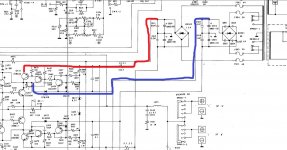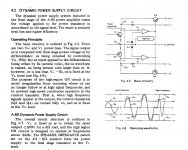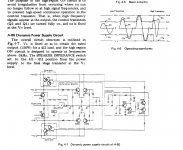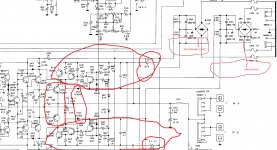NAD made 2 amplifiers that looked identical, the 3130 and the 3240PE
from the outside they look identical but inside a very different story.
which part of the circuit would be the 'PE' bit, or is it just the entire make up of the circuit?
the 3240PE has alot of transistors in comparison to the 3130.
It would just be good to know as i will be working on a few amps going forward with the 'PE', and they look quite complicated.
The attachments have been scanned from my original manuals ,are realy good quality and may help others who have poor quality ones
many thanks 🙂
from the outside they look identical but inside a very different story.
which part of the circuit would be the 'PE' bit, or is it just the entire make up of the circuit?
the 3240PE has alot of transistors in comparison to the 3130.
It would just be good to know as i will be working on a few amps going forward with the 'PE', and they look quite complicated.

The attachments have been scanned from my original manuals ,are realy good quality and may help others who have poor quality ones
many thanks 🙂
Attachments
Last edited:
NAD made 2 amplifiers that looked identical, the 3130 and the 3240PE
from the outside they look identical but inside a very different story.
which part of the circuit would be the 'PE' bit, or is it just the entire make up of the circuit?
AFAIK The PE versions are NAD's take on class G , (i.e. switching higher supply rails in on demand.)
You might follow that better by seeing the route from bridges BD501 and BD502 (over to the right of the output stage)
mike thanks
i presume this makes it a lot more complicated, it certainly looks it to me, although i am not as experienced as you and guys like mooly, so it may just look like it to me 🙂
i presume this makes it a lot more complicated, it certainly looks it to me, although i am not as experienced as you and guys like mooly, so it may just look like it to me 🙂
The amp runs a 'low' voltage rail as normal. That is the one in Blue. Notice the series diode (which I've obliterated in blue) as that is key to how it works.
So low voltage rail and all is normal, the output stage is fed via the diode.
The rail in red is higher voltage. When the audio output reaches a certain level those upper three transistors (which just form a high current 'switch' turn on and feed a higher rail voltage to the amp.
The series diode now stops that higher voltage from 'back feeding' into the low voltage supply.
The negative rail is similar.
This write up is for a Pioneer A80 which is a little bit similar.
So low voltage rail and all is normal, the output stage is fed via the diode.
The rail in red is higher voltage. When the audio output reaches a certain level those upper three transistors (which just form a high current 'switch' turn on and feed a higher rail voltage to the amp.
The series diode now stops that higher voltage from 'back feeding' into the low voltage supply.
The negative rail is similar.
This write up is for a Pioneer A80 which is a little bit similar.
Attachments
mike thanks
i presume this makes it a lot more complicated, it certainly looks it to me, although i am not as experienced as you and guys like mooly, so it may just look like it to me 🙂
See if this helps: (see attached annotated pic)
You can see the normal output drivers on the left (circled) fed from the normal supply via D421 and D423)
As you move across to pic from left to right, the next circled is the Class G (or PE elements - I should have circled D431 and D433 in that circuit element) , and I've ID'd the two supplies finally
Attachments
Last edited:
NAD3240 PE is possibly my favourite commercial amp. The class G output stage is well proportioned for most music. They did skimp a bit on the heat sinks though, so if you overdrive them hard they fail. This is good for me, as they are complex enough to scare a lot of people away, so they can be had quite cheap when they don’t work.
There’s a thread on here about fixing them, which is quite good. I think there are also more expensive NAD amps that are basically the same circuitry but with more transformer and heat sink, but they never come up cheap because they don’t blow up.
There’s a thread on here about fixing them, which is quite good. I think there are also more expensive NAD amps that are basically the same circuitry but with more transformer and heat sink, but they never come up cheap because they don’t blow up.
The amp runs a 'low' voltage rail as normal. That is the one in Blue. Notice the series diode (which I've obliterated in blue) as that is key to how it works.
So low voltage rail and all is normal, the output stage is fed via the diode.
The rail in red is higher voltage. When the audio output reaches a certain level those upper three transistors (which just form a high current 'switch' turn on and feed a higher rail voltage to the amp.
The series diode now stops that higher voltage from 'back feeding' into the low voltage supply.
The negative rail is similar.
This write up is for a Pioneer A80 which is a little bit similar.
yep i understand that, many thanks
my next adventure is interesting, its a NAD(suprise suprise) 3140 in realy good nick, but the lamp lights up like blackpool and its looks like a complicated beastie😱
ill start a new thread on it later, even if i find things quick, it might help others 🙂
ill start a new thread on it later, even if i find things quick, it might help others 🙂
- Home
- Amplifiers
- Solid State
- NAD power envelope



